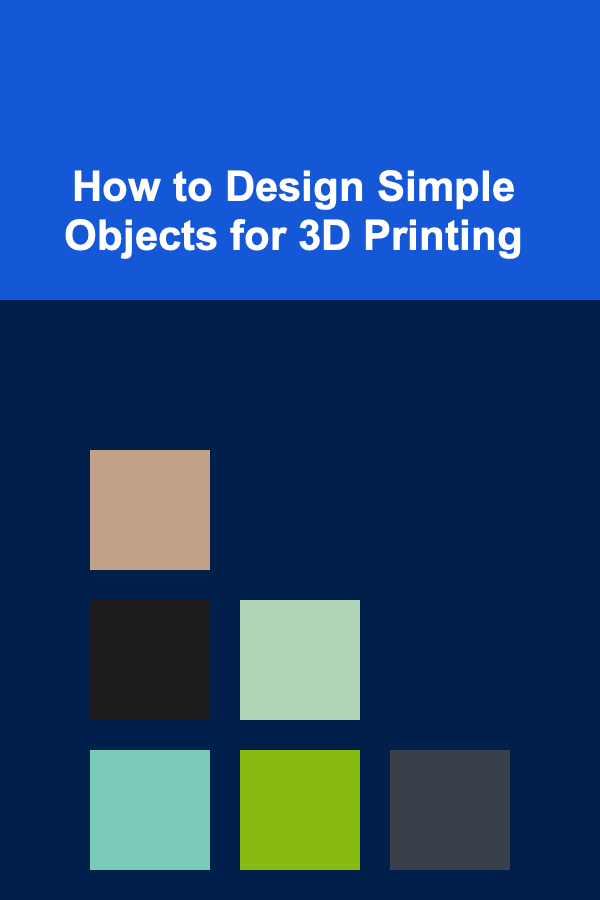
How to Design Simple Objects for 3D Printing
ebook include PDF & Audio bundle (Micro Guide)
$12.99$6.99
Limited Time Offer! Order within the next:

3D printing, also known as additive manufacturing, has revolutionized the way we create and produce objects. Whether you're a hobbyist, a professional, or someone just getting started, the ability to design and print simple objects can open up a world of possibilities. In this article, we will explore how to design simple objects for 3D printing, touching on the fundamentals, tools, and best practices involved in the process.
Understanding 3D Printing
Before diving into the specifics of design, it's important to understand how 3D printing works. 3D printing is an additive process where material is deposited layer by layer to build up an object. Unlike traditional manufacturing techniques, which often involve subtracting material (e.g., cutting, milling), 3D printing allows for the creation of complex shapes and structures with less waste.
The key to a successful 3D print lies in the design. While modern 3D printers are capable of printing intricate and complex models, it's often best to start with simple designs to understand the basic principles of the process.
Basic Design Principles for 3D Printing
When designing for 3D printing, there are several principles that should guide your design choices. These principles help ensure that the object prints correctly, efficiently, and without unnecessary complications. Here are the key principles:
1. Consider Overhangs and Supports
3D printers build objects layer by layer, so each layer needs to be supported by the one below it. When designing an object with overhangs---parts of the design that extend outward without support---it's essential to keep in mind the maximum angle at which a printer can print. Typically, printers can print overhangs up to 45 degrees before needing support.
For simple objects, avoid large, unsupported overhangs. If you must include them, consider adding support structures or using support-free printing techniques like bridging or utilizing the printer's orientation to minimize the need for extra supports.
2. Wall Thickness and Detail
The thickness of the walls in your design will affect the strength, durability, and printability of the object. Generally, it's best to keep wall thicknesses between 1.5mm and 3mm, depending on the size and purpose of the object. Too thin a wall will result in a fragile object, while too thick a wall may waste material and increase print time unnecessarily.
Simple objects with minimal detailing should have uniform thicknesses to ensure strength and stability. If you are designing a small object like a keychain or a figurine, be sure to adjust the thickness accordingly to avoid unnecessary strain on the printer.
3. Avoid Sharp Edges
Sharp edges may cause issues during printing or handling. 3D printers typically have a slight radius at the corners of printed objects due to the nature of the printing process. Therefore, try to avoid designing sharp, acute angles that could cause problems during the print. Instead, use rounded edges or fillets to ensure smooth printing and a better finished product.
4. Minimize Complex Geometry
While 3D printing is capable of producing complex geometries, simpler designs are often more effective, especially for beginners. Simple shapes are easier to create, more reliable to print, and typically require less support. For example, start with basic shapes like cubes, spheres, and cylinders before progressing to more complicated structures. Once you are comfortable with the process, you can gradually experiment with more complex models.
5. Check for Watertight Models
For a 3D model to be printable, it must be "watertight," meaning it must be a solid object with no gaps or holes. If there are any gaps or overlapping faces in your model, the 3D printer will not be able to interpret it correctly, and the print may fail. Many 3D modeling programs have tools that can check for non-manifold geometry and help you fix errors in your design.
6. Use Units Properly
When designing for 3D printing, make sure to use the correct units for your design. Most 3D printers use millimeters (mm) for measurement. If you're working with inches or other units, be sure to convert them to millimeters before proceeding to ensure the object prints to the desired scale.
Choosing the Right Software
The first step in designing an object for 3D printing is choosing the right software. There are various 3D modeling software options available, each with its own set of features, learning curves, and capabilities. For beginners, it's often best to start with simple, user-friendly software before moving on to more complex tools. Here are some popular options for designing simple 3D objects:
1. Tinkercad
Tinkercad is one of the most accessible 3D modeling tools available. It's web-based, free to use, and perfect for beginners. Tinkercad operates using simple shapes like cubes, spheres, and cylinders, and allows you to combine and manipulate them to create more complex designs. It's an ideal starting point for learning the basics of 3D modeling and printing.
2. Fusion 360
Fusion 360 is a more advanced, professional-grade tool from Autodesk. It's free for students and hobbyists and provides a robust set of features for designing 3D models. Fusion 360 is excellent for creating more precise and detailed objects, and it supports parametric modeling, which allows for more flexibility in design changes. While it has a steeper learning curve compared to Tinkercad, it's a great choice for users who want to go beyond simple designs.
3. Blender
Blender is a powerful, open-source tool used for creating both 3D models and animations. It is highly versatile, capable of creating intricate and detailed designs. However, Blender has a steep learning curve and may not be the best tool for beginners. If you're looking to create artistic or more complex organic shapes, Blender is a good option, though it may take some time to master.
4. SketchUp
SketchUp is another popular tool for creating simple 3D designs. It is known for its ease of use, especially for those without prior experience in 3D modeling. SketchUp provides a large library of pre-designed models that you can customize or incorporate into your own projects. It's widely used in architecture, but it can be a great option for simpler 3D prints as well.
Preparing Your Design for 3D Printing
Once you've created your 3D model, the next step is to prepare it for printing. This involves converting the design into a format that the 3D printer can understand and ensuring the model is ready for the printing process. Here's how you can prepare your design for 3D printing:
1. Export Your Design
Most 3D printers use the .STL (stereolithography) file format, which represents the surface geometry of your model. After you've completed your design in your chosen software, export it as an STL file. Some software also allows you to export models in other formats like OBJ or 3MF, but STL is the most commonly used format.
2. Slice the Model
Slicing is the process of converting your 3D model into layers that the 3D printer can print. This is done using slicing software, such as Cura, PrusaSlicer, or Simplify3D. Slicing software generates the G-code, which is the set of instructions the printer follows to create your object.
When slicing your model, you will need to specify several key settings:
- Layer Height: The thickness of each printed layer. Smaller layer heights will result in higher detail, but will also increase print time.
- Infill Density: The amount of internal material used to fill the object. Higher infill densities make the object stronger but also use more material and take longer to print.
- Print Speed: The speed at which the printer moves while printing. Faster speeds can reduce print time, but may also reduce print quality.
- Supports: If your design includes overhangs, you will need to enable support structures in the slicer to ensure successful printing.
3. Check for Errors
Before sending the file to the printer, it's important to check your model for errors. Most slicing software provides a preview function that shows you how the object will be printed layer by layer. This is a great opportunity to catch any potential issues like missing supports, overhangs that are too steep, or incorrect layer alignment.
4. Send the File to the Printer
Once you're satisfied with your design and slicing settings, it's time to send the G-code to the 3D printer. This can be done via USB, SD card, or direct connection, depending on the printer. Make sure your 3D printer is properly set up with the right material (e.g., PLA, ABS) and ready for printing.
Tips for Successful 3D Printing
While the basics of design are important, there are some additional tips to keep in mind when preparing for 3D printing:
1. Test Print Smaller Versions
Before printing your full-size model, it's a good idea to create a smaller version to test the design. This will help you identify potential issues like warping, poor adhesion, or material weaknesses without wasting time and resources.
2. Maintain Your 3D Printer
Regular maintenance of your 3D printer is crucial for consistent performance. Keep the print bed clean, check the nozzle for clogs, and ensure the printer is properly calibrated. Regular maintenance helps avoid printing failures and improves the quality of your prints.
3. Experiment with Different Materials
Different materials can affect the outcome of your 3D prints. PLA is one of the easiest materials to print with, while ABS is more durable but harder to print with due to its tendency to warp. Try experimenting with different materials to understand their properties and how they affect your designs.
4. Pay Attention to Print Settings
The print settings you choose will significantly impact the final outcome. Play around with layer height, infill density, print speed, and support structures to find the optimal balance between print quality and time efficiency.
Conclusion
Designing simple objects for 3D printing doesn't have to be intimidating. By understanding the basic principles of design, choosing the right software, and preparing your model carefully, you can create functional, high-quality prints. With practice, you'll become more confident in your design skills, allowing you to take on more complex and creative projects in the future.
Remember, 3D printing is an iterative process---don't be afraid to experiment and make mistakes. Each print provides valuable experience that will help you refine your skills and produce even better designs down the road. Happy printing!

How to Organize Your Sewing Supplies for Easy Use
Read More
How to Sell Vintage Video Games on eBay: A Comprehensive Guide
Read More
How to Soundproof a Home with Thin Walls
Read More
How to Use Digital Tools to Track Your Goals
Read More
How To Play the Flute: Getting Started
Read More
How to Become a Sustainability Officer: A Step-by-Step Guide
Read MoreOther Products

How to Organize Your Sewing Supplies for Easy Use
Read More
How to Sell Vintage Video Games on eBay: A Comprehensive Guide
Read More
How to Soundproof a Home with Thin Walls
Read More
How to Use Digital Tools to Track Your Goals
Read More
How To Play the Flute: Getting Started
Read More